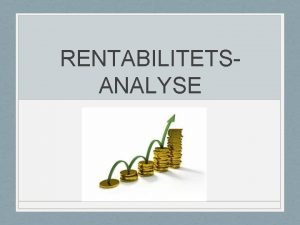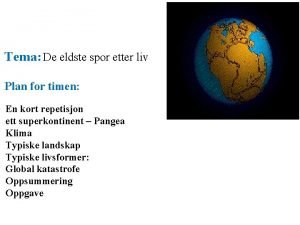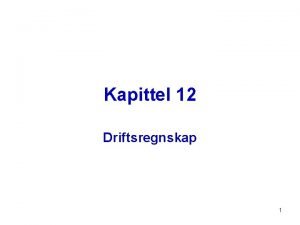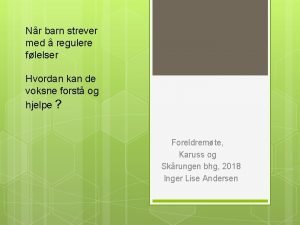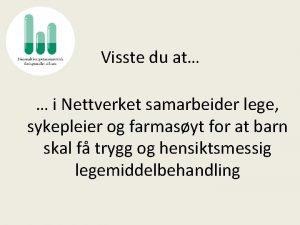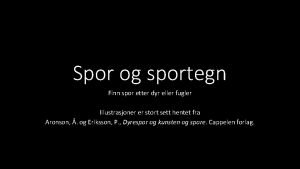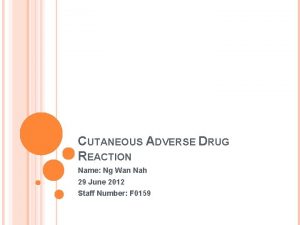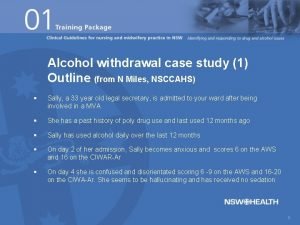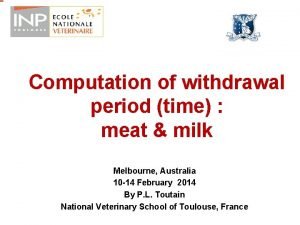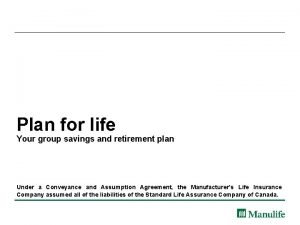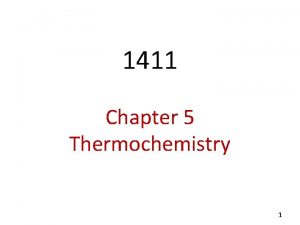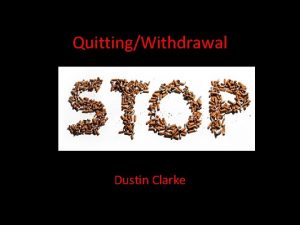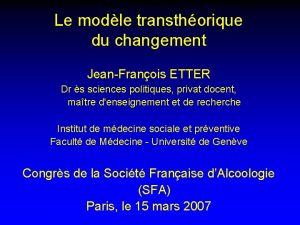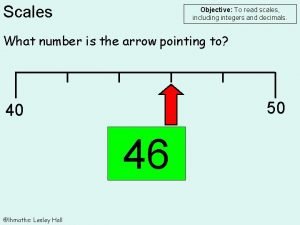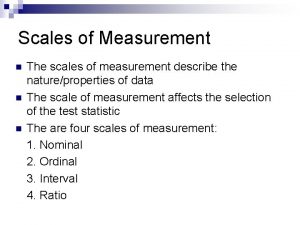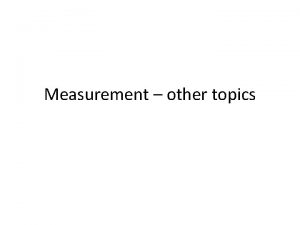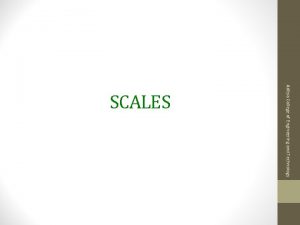A comparison of 3 withdrawal scales JeanFranois ETTER




















- Slides: 20

A comparison of 3 withdrawal scales Jean-François ETTER, Ph. D Institute of social and preventive medicine University of Geneva, Switzerland John R. HUGHES, MD Departments of Psychiatry and Psychology, University of Vermont, Burlington, VT, USA SRNT Tuebingen, Oct. 7, 2004

Background ¨ Valid measures of withdrawal are needed for research and treatment ¨ Many scales are available… ¨ …but no comparison of their performance ¨ Which scale to choose? ¨ Aim: to compare the validity of 3 withdrawal scales

Minnesota Withdr. Form (MWF) ¨ 1986, 8 items: ¨ Depressed mood (sad) ¨ Insomnia ¨ Irritable, frustrated, angry ¨ Anxious (nervous) ¨ Difficulty concentrating ¨ Restless (impatient) ¨ Increased appetite, weight gain ¨ Desire or Craving to smoke ¨ + Total score MWF

Wisconsin Withdr. Scale (WWS) ¨ 1999 ¨ 28 items, 7 subscales: ¨ Anger ¨ Anxiety ¨ Concentration ¨ Craving ¨ Hunger ¨ Sadness ¨ Sleep ¨ + Total score WWS

Cigarette Withdr. Scale (CWS-21) ¨ 2003 ¨ 21 items, 6 subscales: ¨ Depression-Anxiety ¨ Craving ¨ Irritability-Impatience ¨ Appetite-Weight Gain ¨ Insomnia ¨ Difficulty Concentrating ¨ + Total score CWS-21

Methods ¨ Internet survey (in English) on STOP-TABAC. CH ¨ 1 st follow-up after 14 days ¨ 2 nd follow-up after 42 days ¨ Content validity: DSM-IV and ICD-10 ¨ Factor structure: robust in bootstrap resampling? ¨ Reliability: - Cronbach’s alpha - test-retest (0 -14 days) (excluding recent quitters)

Tests of predictive validity ¨ Hypotheses: ¨ In recent ex-smokers (have quit for <31 days): baseline withdr. scores would predict relapse - after 14 days (n = 324) - after 42 days (n = 316) ¨ In baseline smokers who quit at 14 -day retest: change scores between days 0 -14 would predict relapse at day 42 (n = 34)

Tests of construct validity w In 178 recent ex-smokers (quit <1 month) still abstinent at day 14, withdrawal would decrease between days 0 -14 w In 27 smokers who quit between days 0 and 14, withdrawal ratings would increase between days 0 -14 w In 30 ex-smokers who relapsed at retest, withdrawal would decrease between days 0 -14

Results: participation w N = 4644, 67% women, w Current smokers w Former smokers w Never smokers age = 40 44% (median 20 cig. /day) 49% (median 60 days quit) 7% (data not reported here) w USA=50%, Canada=10%, UK=10%, other=30% w 1 st follow-up after 14 days : n = 1309 (28%) w 2 nd follow-up after 42 days: n = 1431 (31%)

DSM-IV: nicotine withdrawal Craving not included ! s Dysphoric or depressed mood s Irritability, frustration or anger s Difficulty concentrating, impaired performance on tasks requiring vigilance s Increased appetite or weight gain s Insomnia s Anxiety s Restlessness, impatience s Decreased heart rate

Results: content validity w All 3 scales covered DSM-IV and ICD-10 criteria of dependence, but… w No scale covered decreased heart rate (DSM-IV) w No scale covered cough, mouth ulcers (ICD-10) w Wisconsin W. Scale did not cover weight gain

Factor analysis, reliability w Factor analysis (MAP test, parallel analysis): - 6 factors in WWS, instead of expected 7 factors, Sadness + Anxiety items loaded on same factor - CWS: 6 factors, as expected - MWF: 1 factor w Cronbach's alpha (0. 76 to 0. 93) were high for all scales +subscales (redundancy in 5 -item scales? ) w Test-retest coefficients: - range 0. 66 -0. 86 for CWS and WWS, - low for some MWF items (range 0. 52 -0. 80)

Predictive validity: baseline scores w In 324 recent ex-smokers, only craving predicted relapse at 14 -day follow-up. w No scale or subscale predicted relapse at 42 days w Area under ROC curve = an accepted quantitative measure of the accuracy of a test w w Relapse day 14, CWS craving: WWS craving: MWF craving: AUC of ROC (95% CI): 0. 63 (0. 55 -0. 71) 0. 58 (0. 51 -0. 66) 0. 64 (0. 56 -0. 73)

Predictive validity: change scores w In 34 smokers who had quit smoking by day 14, an increase in withdrawal between days 0 -14 predicted relapse at day 42: Area under ROC curve (95% CI): w Craving (MWF) 0. 76 (0. 56 -0. 97) w Depressed Mood (MWF) 0. 72 (0. 52 -0. 91) w Total score WWS w Craving (WWS) w Diff. concentrating (WWS) 0. 76 (0. 58 -0. 94) 0. 74 (0. 57 -0. 91)


Change between days 0 -14 in 178 recent quitters (had quit <1 month before baseline) T stat from paired-samples t-test CWS t = 6. 7 WWS t = 8. 1 MWF t = 7. 8 All p<. 001


Construct validity w Hypothesis: withdrawal would increase postcessation: not verified, except for appetite w Unexpected results, probably because of data collection procedure

Conclusions w No scale showed a decisive advantage over the others w MWF: brief w Single items measures in MWF: lower test-retest, but good performance in construct validity tests w More sophisticated tests might show that multi-item scales do better w Craving: performed best, but not in DSM-IV w Further comparisons needed with - Shiffman-Jarvik Scale - Smoker’s Complaint Scale - Mood and Physical Symptoms Scale (MPSS)

Acknowledgements w No external funding w Vincent Baujard, from HON foundation (www. hon. ch), developed the software for data collection
 Totalkapital rentabilitet
Totalkapital rentabilitet Hva er neglekt
Hva er neglekt Spor etter pangea
Spor etter pangea Driftsregnskap etter bidragsmetoden
Driftsregnskap etter bidragsmetoden Søk etter bilder
Søk etter bilder Paracet mikstur holdbarhet etter åpning
Paracet mikstur holdbarhet etter åpning Grevlingbæsj
Grevlingbæsj Compairson test
Compairson test Topicsl steroid withdrawal
Topicsl steroid withdrawal Unf medical withdrawal
Unf medical withdrawal Nsccahs
Nsccahs Asu withdrawal
Asu withdrawal Progression of job withdrawal theory
Progression of job withdrawal theory Advant edge advisors
Advant edge advisors Prediction verification replication aba
Prediction verification replication aba Landbank payroll system
Landbank payroll system Meat and milk withdrawal times
Meat and milk withdrawal times Optum bank hsa
Optum bank hsa Manulife viproom
Manulife viproom 1411 atm withdrawal meaning
1411 atm withdrawal meaning Exaggerated physical deficiencies
Exaggerated physical deficiencies
